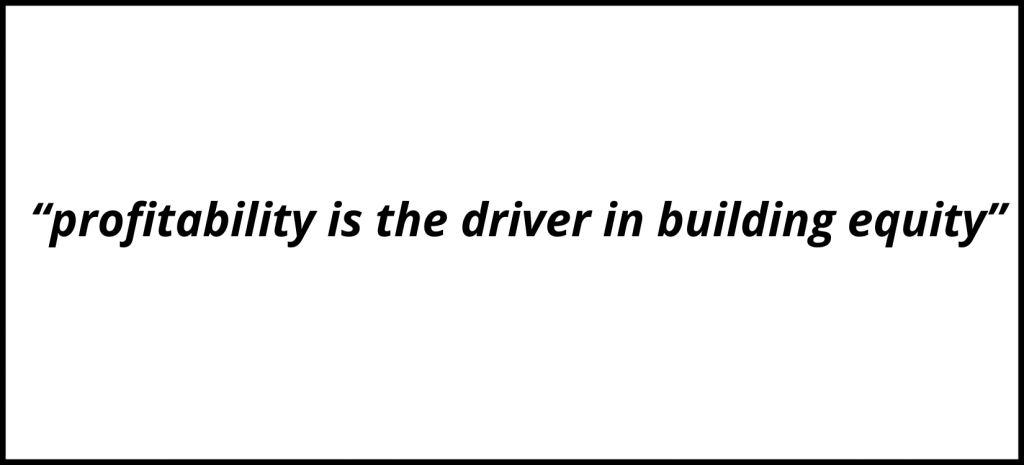What’s the real driver of value in a brokerage?
“Why would I sell if I was making that kind of money,” he asked dismissively.
The broker wanted to discuss selling his brokerage and cashing out. He had just voiced his thoughts on its value, and he had a really big number in mind. The discussion was complicated by the fact that the firm was not very profitable. In fact, it was his own large team within the brokerage that provided both his personal income and covered much of the fixed overhead. Subtract the earnings of the team, and even with all of the other agents’ production, the company lost money.

As the market cooled, operating multiple offices with all the associated expenses had become costly. When I explained how much his true profits needed to be to justify the dollars he had in mind, the conversation went south… meeting adjourned.
Over the last 36-years of assisting business owners in selling their firms, I’ve seen a lot of techniques used to value companies. (My personal favorite is the “per foot method” meaning how much per foot the boat the broker plans to buy from the proceeds will cost.) The point is that establishing a true value of a real estate firm is a complex and challenging process.
The single most important asset of a brokerage is the agents, and they are free to leave at any time… which they do. The challenge is putting a value on a company whose independent contractors have legs that take them out the door. While there are pricing ranges bandied about such as two to five times earnings for example as well as structures including earn outs on future production, there are numerous factors which drive a brokerage’s value.
The math is the ultimate value driver. The math is the acid test. Basically, there must be enough adjusted income after expenses to cover debt service and still leave profit for a reasonable return to a prospective buyer. Brokers tell me all the time “a new owner can come in and cut costs while building the sales up.” That is true and buyers will purchase with a firm’s potential in mind, but generally they will pay a price that is based on history. Buyers typically won’t pay a premium for the privilege of having to grow a company just so they can pay the previous owner their fantasy price. 
Today, companies are selling for strong prices, but it is all about profitability—I like to call it the “P-Word.” For the brokerage owner, profitability is the driver in building equity and company value. As the market continues to shift, there are limits to how much the operational expenses can be reduced to increase profit without jeopardizing the company’s value.
Remember- You cannot save your way to prosperity– so focusing on profit drivers makes sense today.
1. Company dollar – In a real estate brokerage, company dollar is the primary driver of the bottom line. Company dollar is the gross profit, and it has seen better days having dropped by more than 40% over the past decade; accordingly, brokers’ profits have been significantly reduced. How do you turn this around? Focus on providing tech-driven lead generation in which agent leads are provided but at more equitable commission splits; driving higher conversion rates through better systems; increasing recruiting and targeting mid-range agents who are at lower commission splits.
2. Agent Per Person Productivity (PPP) – What percent of your agents are truly productive; how many listings are they winning; and how many transactions are they averaging? Do you measure how do your agents compare to the market? PPP is the driver of their success and ultimately of yours. A good PPP is your best recruiting and retention tool because it drives the agents’ success and earnings. Increase your agents’ production and you will change their lives and reduce turnover (and keep those agents) as well as increase the value of your brokerage.
3. Increasing your Average Sales Price (ASP) – Increasing the ASP boosts the agents’ commissions, your company dollar and ultimately your profits. Your focus should be to increase your ASP, but keep in mind mid-range properties are more abundant and they provide the opportunity to close more sides which is in everyone’s best interests. Increasing the sides along with a higher ASP equals greater success. Prestige and luxury buyers are often not local so making a strong impression with these buyers is key. Invest in the necessary resources; including marketing, technology, photos, videos (and quality agents) to appeal to this segment. These investments better enable you and your brokerage to stand out.
4. Recruiting on your value proposition instead of commission splits – Recruiting on value is much more effective and profitable than simply matching your competitor’s splits. When your agents have the resources to win at the kitchen table in getting listings and closing transactions recruiting becomes easier and more profitable. Agents would much rather brag about their 1099s instead of their commission splits. Your recruiting should focus on moderate producers at lower splits because the value you provide to those agents can increase their production and earnings while still maintaining good company dollar.
5. Adding ancillary services – Adding additional services increases profitability which has dropped due to; increasing broker costs, decreasing commissions and ever-higher agent splits. Many brokers diversify their income streams by adding title, mortgage, staging and sale preparation, property management, cash offers, real estate marketing/lead generation and more.
Finally, consider a growth partner to improve your value proposition and profits. Companies seeking to increase value often look for a growth partner to provide needed resources such as expertise, nationally-recognized branding, technology, tools, systems, training and support, referrals, relocation services, acquisition assistance and ancillary services. Profitable growth requires proper funding, and many companies today prefer not to invest their own capital but instead look for a partner to provide the funding needed to accelerate their value.
This article was written by Rick Ellis, MBA and published in Realty Biz News
Corcoran sails into Charleston, South Carolina
Corcoran HM Properties has expanded its growing operation into Charleston, South Carolina marking the eighth Corcoran affiliate to enter a new market this year. 
This expansion is a strategic step for Corcoran HM Properties’ growth and broadens its reach from the Charlotte, North Carolina region to the greater Charleston area, including Mt. Pleasant, Sullivan’s Island, Isle of Palms, and more. Charleston attracts many second-home buyers and open doors for the entire southeastern Corcoran network of offices.
Congratulations to founder Valerie Mitchener and the entire Corcoran HM Properties team. For more details: click here.

Now in 45 markets with 170+ offices, Corcoran is the number one fastest growing real estate franchise brand according to T3 Sixty Enterprise 20 Report. Corcoran is growing and we’re looking for a few good firms to grow with. Click here to learn about the Corcoran Network.
Realtor.com says the real estate market will get hammered: what you should know

Mortgage interest rates are expected to keep rising, likely surpassing 6%, in response to stubbornly high inflation. This could accelerate the housing market correction, which is already well underway, by making purchasing a home even more expensive for cash-strapped buyers, pricing many completely out of the market. Read full article.
Three real estate predictions for the rest of 2022
Whether you’re a real estate investor or an everyday person hoping to buy a home, it’s important to know what to expect from the housing market during the latter part of 2022. Here’s what we could be in for during the year’s final quarter. Learn more.
“As recession concerns weigh on consumer outlooks, our survey shows uncertainty has made its way into the minds of many buyers,” said Danielle Hale, chief economist at Realtor.com. Read more.
Industry changing blue print
Inman recently convened a gathering of top industry leaders during Inman Connect Las Vegas. During the meeting, the leaders were asked to share their best advice for other members of the industry. The tips they shared ranged from how to lead well to advice on what consumers actually want. What follows is a blueprint of how to succeed based on those tips. See article.


